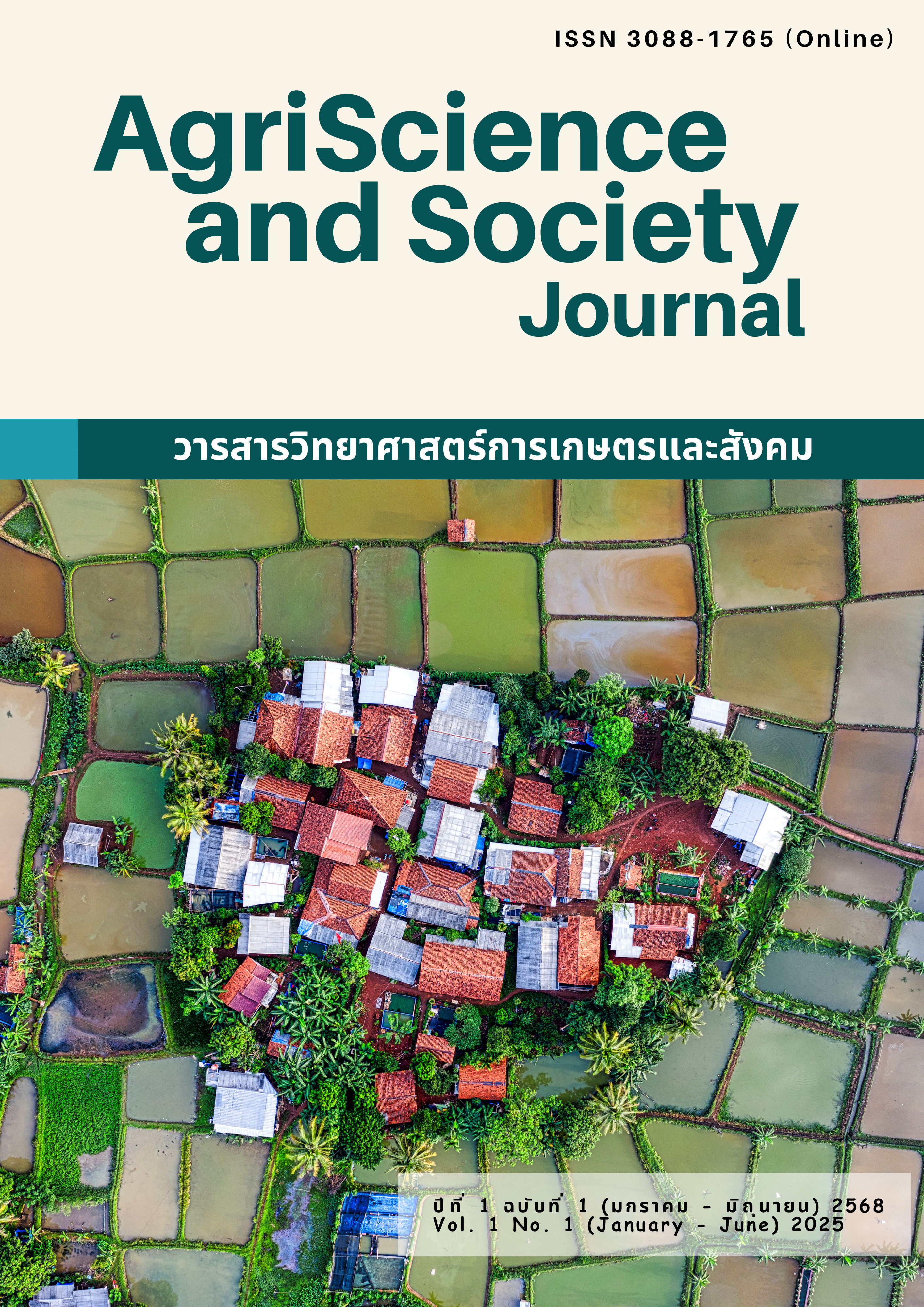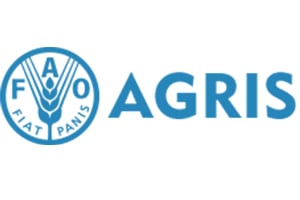Selection of Native Entomopathogenic Nematode from Southern Thailand for Developing EPN-based Bioproduct
Keywords:
Entomopathogenic nematode, EPN-based bioproduct , biological controlAbstract
Entomopathogenic nematode (EPN) is one of the important biological control agents for controlling key agricultural insect pests, ensuring safety for non-target organisms and the environment. This study was conducted to screen the effective local EPNs from soil samples collected from four provinces in southern Thailand. The results found that EPN from Pattani province ultimately killed 100% of the tested larvae, wax moth (Galleria mellonella), within 2 days. From the visible symptoms of infected wax moth and the morphological characteristics of selected EPN under a microscope and morphometric study, it could be identified that the selected EPN was Heterorhabditis sp. Subsequently, Heterorhabditis sp. was developed into an EPN-based bioproduct. Regarding the Plackett−Burman design, evaluating the solubility of the product, viability of EPN, and host infection ability resulted in selecting high-affected formulation components, including kaolin, Tween 20, CMC, formalin, and sodium polyacrylate.
References
Adams, B.J., and Nguyen, K.B. (2002). Taxonomy and systematics of the genus Heterorhabditis. Nematology, 4, 26–54.
Alekseev, E., Glazer, I., and Samish, M. (2006). Effect of soil texture and moisture on the activity of entomopathogenic nematodes against female Boophilus annulatus Ticks. BioControl, 51, 507–518. https://doi.org/10.1007/s10526-005-2935-9
Ansari, M. Hussain, M.A., and Moens, M. (2009). Formulation and application of entomopathogenic nematode-infected cadavers for control of Hoplia philanthus in turfgrass. Pest Management Science, 65, 367–374. https://doi.org/10.1002/ps.1699
Ardpairin, J., Muangpat, P., Sonpom, S., Dumidae, A., Subkrasae, C., Tandhavanant, S., Thanwisai A. and Vitta, A. (2020). A survey of entomopathogenic nematodes and their symbiotic bacteria in agricultural areas of northern Thailand. Journal of Helminthology, 94, e192. https://doi.org/10.1017/S0022149X20000735
Bamel, V., Sirohi, A., and Sabir, N. (2021). Survival and infectivity of entomopathogenic nematode Heterorhabditis indica Poinar, Karunakar & David incubated in solutions containing different spray adjuvants. Journal of Entomology and Zoology Studies, 9, 794–799.
Cimen, H. (2023). The role of Photorhabdus-induced bioluminescence and red cadaver coloration on the deterrence of insect scavengers from entomopathogenic nematode-infected cadavers. Journal of Invertebrate Pathology, 196, 107871. https://doi.org/10.1016/j.jip.2022.107871
Consabo, L., Pillada, E.M.G., Gallego, A.M. and Panaligan, A.C.G. (2025). Occurrence, isolation, and identification to genus level of entomopathogenic nematodes (epns) in Central Panay Island, Philippines. International Journal of Agricultural Technology, 21, 603–616. https://doi.org/10.63369/ijat.2025.21.2.603-616
Cruz-Martínez, H., Ruiz-Vega, J., Matadamas-Ortíz, P.T., Cortés-Martínez, C.I. and Rosas-Diaz, J. (2017). Formulation of entomopathogenic nematodes for crop pest control–a review. Plant Protection Science, 53, 15. https://doi.org/10.17221/35/2016-PPS
Dziegielewska, M. and Skwiercz, A. (2018). The influence of selected abiotic factors on the occurrence of entomopathogenic nematodes (Steinernematidae, Heterorhabditidae) in soil. Polish Journal of Soil Science, 51. https://doi.org/10.17951/pjss/2018.51.1.11
Fallet, P., Bazagwira, D., Guenat, J. M., Bustos-Segura, C., Karangwa, P., Mukundwa, I. P., Kajuga, J., Degen, T., Toepfer, S., and Turlings, T.C.J. (2022). Laboratory and field trials reveal the potential of a gel formulation of entomopathogenic nematodes for the biological control of fall armyworm caterpillars (Spodoptera frugiperda). Biological Control, 176, 105086. https://doi.org/10.1016/j.biocontrol.2022.105086
Glazer, I., and Lewis, E.E. (2000). Bioassays for entomopathogenic nematodes. In: Navon, A. and Ascher, K.R.S. (Eds.). Bioassays of Entomopathogenic Microbes and Nematodes. CABI Publishing, Wallingford, UK, pp. 229–247.
Hazir, S., Kaya, H., Touray, M., Cimen, H., and Ilan, D.S. (2022). Basic laboratory and field manual for conducting research with the entomopathogenic nematodes, Steinernema and Heterorhabditis, and their bacterial symbionts. Turkish Journal of Zoology, 46, 305–350. https://doi.org/10.55730/1300-0179.3085
Hiltpold, I. (2015). Prospects in the application technology and formulation of entomopathogenic nematodes for biological control of insect pests. Nematology, 17, 499–507. https://doi.org/10.1007/978-3-319-18266-7_7
Hominick, W.M., Briscoe, B.R., del Pino, F.G., Heng, J., Hunt, D.J., Kozodoy, E., Mracek, Z., Nguyen, K.B., Reid, A.P., Spiridonov, S., Stock, P., Sturhan, D., Waturu, C., and Yoshida, M. (1997). Biosystematics of entomopathogenic nematodes. Journal of Helminthology, 71, 271–298. https://doi.org/10.1017/S0022149X00016096
Husain, M., Rasool, K.G., Sutanto, K.D., Omer, A.O., Tufail, M., and Aldawood, A.S. (2024). Laboratory evaluation of indigenous and commercial entomopathogenic nematodes against red palm weevil, Rhynchophorus ferrugineus (Coleoptera: Curculionidae). Insects, 15, 290. https://doi.org/10.3390/insects15040290
Kagimu, N., Ferreira, T., and Malan, A.P. (2017). The attributes of survival in the formulation of entomopathogenic nematodes utilised as insect biocontrol agents. African Entomology, 25, 275–291. https://hdl.handle.net/10520/EJC-9e1e16147
Kary, N.E., Chahardoli, S., Mohammadi, D., and Dillon, A.B. (2021). Efficacy of carboxymethyl cellulose as an inert water-soluble carrier for formulation of entomopathogenic nematodes, Heterorhabditis bacteriophora and Steinernema carpocapsae. Biological Control, 160, 104690. https://doi.org/10.1016/j.biocontrol.2021.104690
Kaur, S., Thakur, N., and Yadav, A.N. (2024). Evaluation of different mass production techniques to enhance the progeny of isolated indigenous entomopathogenic nematodes from Indian Himalayan region. National Academy Science Letters, 1–6. https://doi.org/10.1007/s40009-024-01506-0
Kaya, H.K., and Stock, S.P. (1997). Techniques in insect nematology. Manual of Techniques in Insect Pathology, 281-324 https://doi.org/10.1016/B978-012432555-5/50016-6
Lewis, E.E., Campbell, J., Griffin, C., Kaya, H., and Peters, A. (2006). Behavioral ecology of entomopathogenic nematodes. Biological Control, 38, 66–79. https://doi.org/10.1016/j.biocontrol.2005.11.007
Lucskai, A. (1999). Identified key to entomopathogenic nematode species. Acta phytopathologica et entomologica hungarica, 34, 317–325. https://doi.org/10.1556/aphyt.34.1999.4.7
Martinez, H.C., Ruiz-Vega, J., Matadamas-Ortíz, P.T., Martínez, C.I.C., and Diaz, J.R. (2017). Formulation of entomopathogenic nematodes for crop pest control: A review. Plant Protection Science, 53, 15–24. https://doi.org/10.17221/35/2016-PPS
Nimkingrat, P., Siri, N., and Chadamek, C. (2014). Efficacy of the entomopathogenic nematodes against whiteflies, Bemisia tabaci (Homoptera: Aleyrodidae), in chili peppers under laboratory and field conditions. Khon Kaen Agriculture Journal, 42, 255–264.
Nguyen, K.B. and Smart, Jr. G.C. (1996). Identification of entomopathogenic Nematode in the Steinernema and Heterorhabditidae (nemata: Rhabditida). Journal of Nematology, 28, 286–300.
Nguyen, K.B., and Hunt, D.J. (2007). Entomopathogenic nematodes: systematics, phylogeny and bacterial symbionts. Nematology Monographs, 5, 1–816.
Noosidum, A., Hodson, A.K., Lewis, E.E., and Chandrapatva, A. (2010). Characterization of new entomopathogenic nematodes from Thailand: Foraging behavior and virulence to the greater wax moth, Galleria mellonella L. (Lepidoptera: Pyralidae). Journal of Nematology, 42, 281–291.
Noosidum, A., Chandrapatya, A., and Lewis E.E. (2016). An important method for entomopathogenic nematode application to control diamondback moth, Plutella xylostella L. (Lepidoptera: Plutellidae) and common cutworm, Spodoptera litura F. (Lepidoptera: Noctuidae) larvae in vegetable crops. Available from:
https://digital.library.tu.ac.th/tu_dc/digital/api/DownloadDigitalFile/dowload/64578 [accessed 24 November 2024]
Office of Science for Land Development. (2004). Methods of soil analysis and interpretation for soil survey and classification: Physical Properties. Available from:
http://www1.ldd.go.th/WEB_PSD/pdf/expert%20work/ex22/3-3.pdf [accessed 21 December 2024]
Onwong, R., Khwanket, N., Rattanawannee, A., Rajchanuwong, P., and Noosidum, A. (2021). Molecular identification of entomopathogenic nematodes of the Genus Heterorhabditisin Thailand and pathogenicity to larvae of the greater wax moth, Galleria mellonella L. (Lepidoptera: Pyralidae). Khon Kaen Agriculture Journal, 49, 1583–1586.
Orozco, A.R., Lee, M., and Stock, S.P. (2014). Soil sampling and isolation of entomopathogenic nematodes (Steinernematidae, Heterorhabditidae). Journal of Visualized Experiments, 89, 52083. https://doi.org/10.3791/52083
Plackett, R.L., and Burman, J.P. (1946). The design of optimum multifactorial experiments. Biometrika, 33, 305–325. https://doi.org/10.2307/2332195
Poinar, G.O.Jr. (1990). Taxonomy and biology of Heterorhabditidae and Steinernematidae. In Kaya, H.K. and Guagler, R. (Eds.). Entomopathogenic Nematodes in Biological Control. CRC Press. Boca Raton. Florida, USA. page 42. https://doi.org/10.1201/9781351071741
Sharmila, R., Priya, M.S., Subramanian, S., Poornima, K., and Pandiyan, M. (2018). Review on ecology of entomopathogenic nematodes. Journal of Entomology and Zoology Studies, 6, 1086–1093.
Stock, S.P. and Kaya, H.K. (1996). A multivariate analysis of morphometric characters of Heterorhabditis species. Journal of Parasitology, 82, 806–813. https://doi.org/10.2307/3283895
Tangchitsomkid, N., and Kositcharoenkul, N. (2013). Taxonomy of Steinernema and Heterorhabditis. Availability from: https://www.doa.go.th/research/attachment.php?aid=2004 [accessed on 24 November 2024]
White, G.F. (1927). A method for obtaining infective nematode larvae from cultures. Science, 66, 302–303. https://doi.org/10.1126/science.66.1709.302.b
Wu, S., Li, Y., Toews, M. D., Mbata, G., and D. I. Shapiro-Ilan. (2023). Novel formulations improve the environmental tolerance of entomopathogenic nematodes. Biological Control, 186, 105329. https://doi.org/10.1016/j.biocontrol.2023.105329
Yooyangket, T., Muangpat, P., Polseela, R., Tandhavanant, S., Thanwisai, A. and Vitta, A. (2018). Identification of entomopathogenic nematodes and symbiotic bacteria from Nam Nao National Park in Thailand and larvicidal activity of symbiotic bacteria against Aedes aegypti and Aedes albopictus. PloS One, 13, e0195681. https://doi.org/10.1371/journal.pone.0195681
Downloads
Published
How to Cite
Issue
Section
License
Copyright (c) 2025 คณะทรัพยากรธรรมชาติ

This work is licensed under a Creative Commons Attribution-NonCommercial-NoDerivatives 4.0 International License.
Natural Resources and Agricultural Sciences Journal is licensed under a Creative Commons Attribution-NonCommercial-NoDerivatives 4.0 International (CC BY-NC-ND 4.0) licence, unless otherwise stated. Please read our Policies page for more information on Open Access, copyright and permissions.






